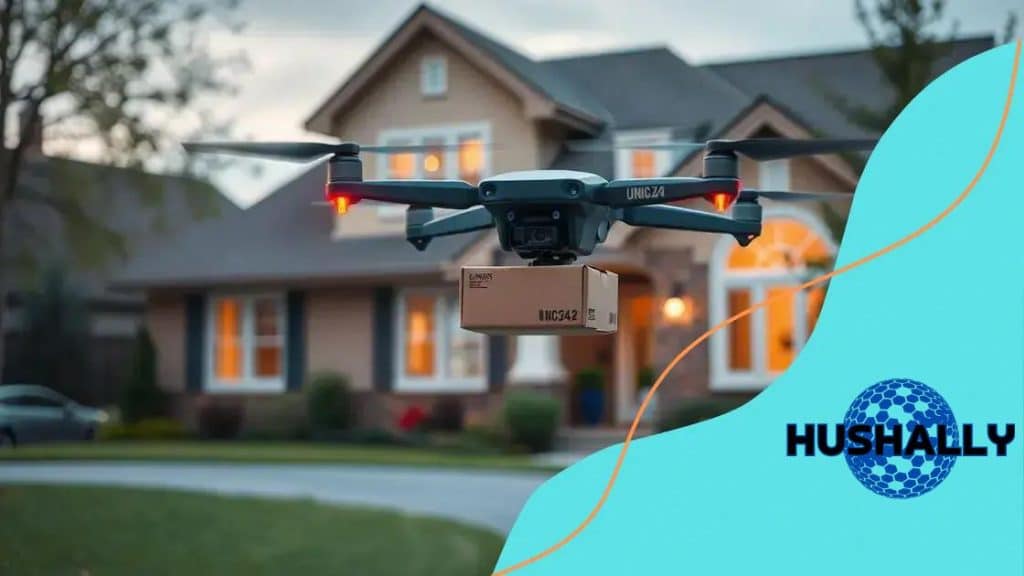Drone technology revolutionizing delivery services

Drone technology revolutionizing delivery services enhances efficiency, reduces delivery times, and lowers costs while addressing challenges such as regulations and public acceptance, making it a vital component of modern logistics.
Drone technology revolutionizing delivery services is not just a futuristic concept; it’s becoming a reality that impacts your daily life already. Have you ever wondered how those packages arrive at your door faster than ever? Let’s dive into this technological shift.
How drones are transforming last-mile logistics
Drones are changing the game in last-mile logistics. These flying devices are not just a cool tech trend; they are making deliveries faster and more efficient. Imagine a world where your package arrives within minutes rather than days. This is becoming a reality with the rise of drone technology.
Many companies are adopting drones to enhance their delivery systems. Drones can navigate through traffic and reach hard-to-access areas quickly. This leads to reduced delivery times and happier customers. However, it’s not just about speed. Drones also help reduce delivery costs, making them an attractive option for businesses.
The advantages of using drones in deliveries
Utilizing drones for deliveries offers several benefits:
- Speed: Drones can deliver packages in a fraction of the time compared to traditional methods.
- Cost-effective: They reduce labor and fuel costs associated with ground transportation.
- Environmentally friendly: Drones are typically electric, leading to lower emissions.
- Accessibility: Drones can reach remote areas that trucks and vans struggle with.
Furthermore, many companies are testing drone delivery systems right now. These innovations allow businesses to stay competitive and meet customer demands. By implementing drone technology, they can streamline their operations and improve efficiency.
Challenges in drone delivery
Despite their potential, there are challenges that need to be addressed:
- Regulations: Navigating airspace regulations can be complicated.
- Safety: Ensuring drones operate safely around people and property is crucial.
- Technical limitations: Battery life and payload capacity can limit drone deliveries.
As technology evolves, we may see solutions to these challenges. Overcoming these barriers is critical for broader adoption. The future of last-mile logistics seems bright with the integration of drones.
In summary, drones are transforming last-mile logistics by providing speed, efficiency, and cost-effectiveness. By addressing challenges and embracing innovations, businesses can take advantage of this exciting technology.
Benefits of using drones for delivery
The use of drones for delivery is on the rise, and for good reason. These flying machines offer numerous advantages that enhance the logistics industry. Fast deliveries are just one benefit, but there are many more that improve service and efficiency.
One of the key benefits is the reduced delivery time. Traditional delivery methods can be hindered by traffic or road conditions. However, drones can bypass these obstacles, ensuring packages reach their destination quickly. This rapid service increases customer satisfaction and boosts loyalty.
Cost-effectiveness of drones
Using drones can significantly lower operational costs. Some major savings include:
- Decreased labor costs since fewer human resources are needed for deliveries.
- Lower fuel expenses, as drones typically run on electricity.
- Reduced vehicle maintenance costs associated with a traditional fleet.
This financial benefit makes drone delivery appealing for businesses, especially startups looking to optimize their budgets.
Environmental impact
Another major advantage is the environmental impact. Drones generally produce fewer emissions than delivery trucks and vans. By reducing their carbon footprint, companies can contribute positively to the planet. This eco-friendly appeal can attract customers who prioritize sustainability.
Additionally, drones can access remote areas that are hard to reach with conventional delivery methods. This means that supplies can be delivered to underserved locations, improving overall access and convenience. For people in rural areas, this technology can be especially transformative.
In conclusion, the benefits of using drones for delivery are numerous. From faster delivery times and cost savings to environmental advantages and improved access, this technology represents a significant leap forward in logistics.
Challenges faced by drone delivery services

While drones offer exciting possibilities for delivery services, they also face several challenges. These hurdles can impact their efficiency and acceptance in the market. Understanding these issues is crucial for companies looking to implement drone technology.
One of the main challenges is regulatory compliance. The drone industry is still evolving, and laws surrounding their operation are constantly changing. These regulations vary from country to country, creating uncertainty for businesses. Companies must stay informed about these regulations to avoid fines and operational delays.
Safety and operational challenges
Safety is another significant concern with drone deliveries. Ensuring that drones can operate without accidents is critical. Risks include:
- Collisions with buildings, vehicles, or other drones.
- Accidental drops of packages that may harm people or property.
- Technical failures that could lead to crashes.
To address these issues, companies need to invest in advanced technology, such as sophisticated navigation systems and collision-avoidance features. Further research into safety measures can help minimize these dangers.
Public perception and acceptance
Another challenge is gaining public acceptance. Many people are still unfamiliar with drone technology and may have concerns regarding privacy and noise. Some individuals worry about how drone deliveries could affect their neighborhoods. To overcome this, companies must engage with communities and demonstrate the benefits of drone deliveries.
Additionally, pilots and operators must be trained adequately to ensure safe operations. Building a skilled workforce is essential as the demand for drone deliveries grows. Ensuring that operators understand how to manage drones efficiently will help improve safety and reliability.
In summary, while the potential of drones in the delivery sector is immense, overcoming challenges like regulations, safety concerns, and public perception will be key to their successful integration into logistics systems.
Future of drone technology in logistics
The future of drone technology in logistics is bright and filled with opportunities. As technology continues to evolve, we can expect significant advancements that will enhance delivery systems around the world. Innovations will enable companies to deliver more efficiently and meet rising customer demands.
One area showing great promise is the development of autonomous drones. With advancements in AI and machine learning, these drones will be able to navigate complex environments without human intervention. This can increase the speed of deliveries and minimize human error, resulting in a seamless logistics process.
Integration with smart logistics systems
Another exciting aspect is how drones will integrate with smart logistics systems. Companies are beginning to use advanced software to analyze data, optimize routes, and improve inventory management. Drones can become a vital part of this system, helping businesses respond quickly to changes in supply and demand.
- Real-time tracking: Customers will have the ability to see exactly where their packages are located at all times.
- Dynamic routing: Drones can adapt their flight paths based on traffic and weather conditions.
- Automated inventory: Drones can assist in inventory checks, ensuring stock levels are always accurate.
The future also brings improvements in battery technology. Longer battery life will allow drones to cover greater distances without needing to recharge. This will expand the range of deliveries, making remote locations more accessible than ever before.
Environmental considerations
As businesses aim for sustainability, the environmental impact of logistics will come to the forefront. Drones are typically more energy-efficient than traditional delivery methods. This means that as they become more widely adopted, they could significantly reduce greenhouse gas emissions in the logistics sector.
Furthermore, regulations will continue to evolve alongside technological advancements. Governments will create frameworks to ensure safe and efficient drone operations in the skies. This will facilitate broader usage and trust in drone delivery systems.
As we look ahead, we can conclude that the future of drone technology in logistics is filled with potential. The combination of advanced technology, smart integration, and environmental benefits will shape a new era for delivery services.
Real-world examples of drone delivery success
There are several exciting real-world examples of drone delivery success that highlight the potential of this technology. These instances showcase how companies are effectively integrating drones into their logistics operations, providing benefits to customers and businesses alike.
One prominent example is Zipline, a company delivering medical supplies via drones in remote areas. They have made significant impacts in countries like Rwanda and Ghana by providing timely deliveries of blood and vaccines. This has revolutionized healthcare access, allowing medical professionals to save lives and improve patient outcomes.
Walmart’s drone delivery initiative
Another example is Walmart, which has begun testing drone deliveries in select locations in the United States. They aim to use drones for delivering groceries and household items. The service can significantly reduce delivery times, especially in urban areas. Walmart’s project demonstrates how major retailers are investing in drone technology to enhance customer convenience and streamline operations.
- Fast delivery services directly from stores.
- Reduced operational costs for last-mile logistics.
- Increased customer satisfaction through quicker service.
Furthermore, Amazon has been a leader in drone delivery innovation. Their Prime Air service aims to deliver packages within 30 minutes of ordering. Although still in the testing phase, Amazon’s investment shows the company’s commitment to transforming e-commerce logistics. Their advanced technology and infrastructure could redefine how consumers receive their products.
Partnerships and developments
Additionally, companies like Wing, a subsidiary of Alphabet, have launched their own delivery services in specific regions. Wing is delivering small packages like snacks and drinks in towns across Australia and the U.S. Their service focuses on speed and customer satisfaction. This shows that there is a growing acceptance of drones in everyday life, with more consumers embracing their use.
These real-world examples of drone delivery success illustrate the versatility and effectiveness of drone technology in logistics. As more companies adapt and innovate, the future of delivery services looks promising, with drones playing a pivotal role.
Conclusion: The future of drone technology in delivery services is bright. As we’ve seen through various real-world examples, companies are successfully implementing drones for tasks like delivering medical supplies and groceries. These innovations not only improve efficiency but also enhance customer satisfaction. As challenges like regulations and public perception are addressed, we can expect to see even greater advancements. Drones are set to play a crucial role in transforming how we receive goods, making logistics faster and more sustainable.
FAQ – Frequently Asked Questions about Drone Delivery Technology
How do drones improve delivery times?
Drones can bypass traffic and navigate directly to delivery locations, significantly reducing delivery times compared to traditional methods.
What are the challenges of using drones for delivery?
Challenges include regulatory compliance, safety concerns, and gaining public trust regarding privacy and noise.
How are companies currently using drone delivery?
Companies like Zipline are using drones to deliver medical supplies efficiently in remote areas, while Walmart and Amazon are testing drone deliveries for groceries and packages.
What is the environmental impact of drone deliveries?
Drones generally have a lower carbon footprint compared to delivery trucks, making them an environmentally friendly option for logistics.





